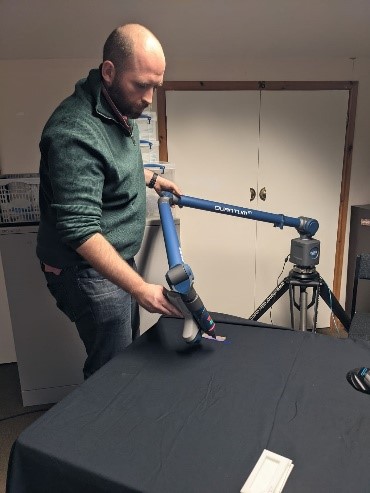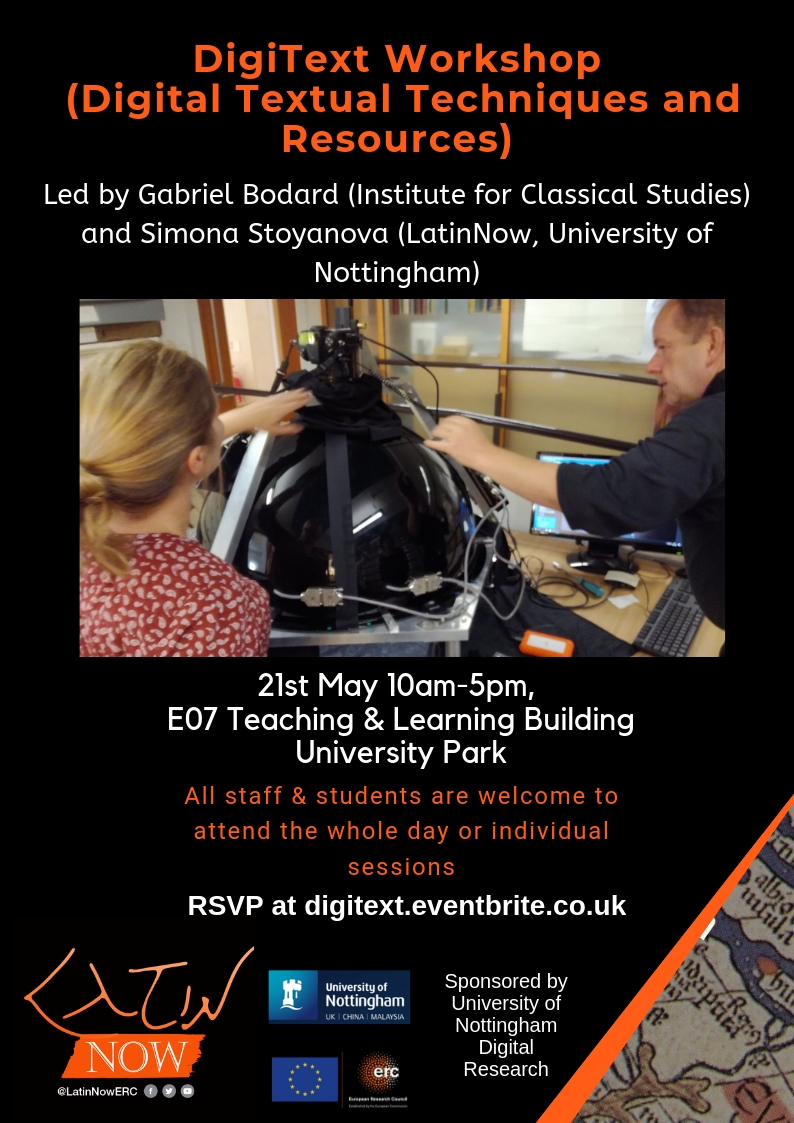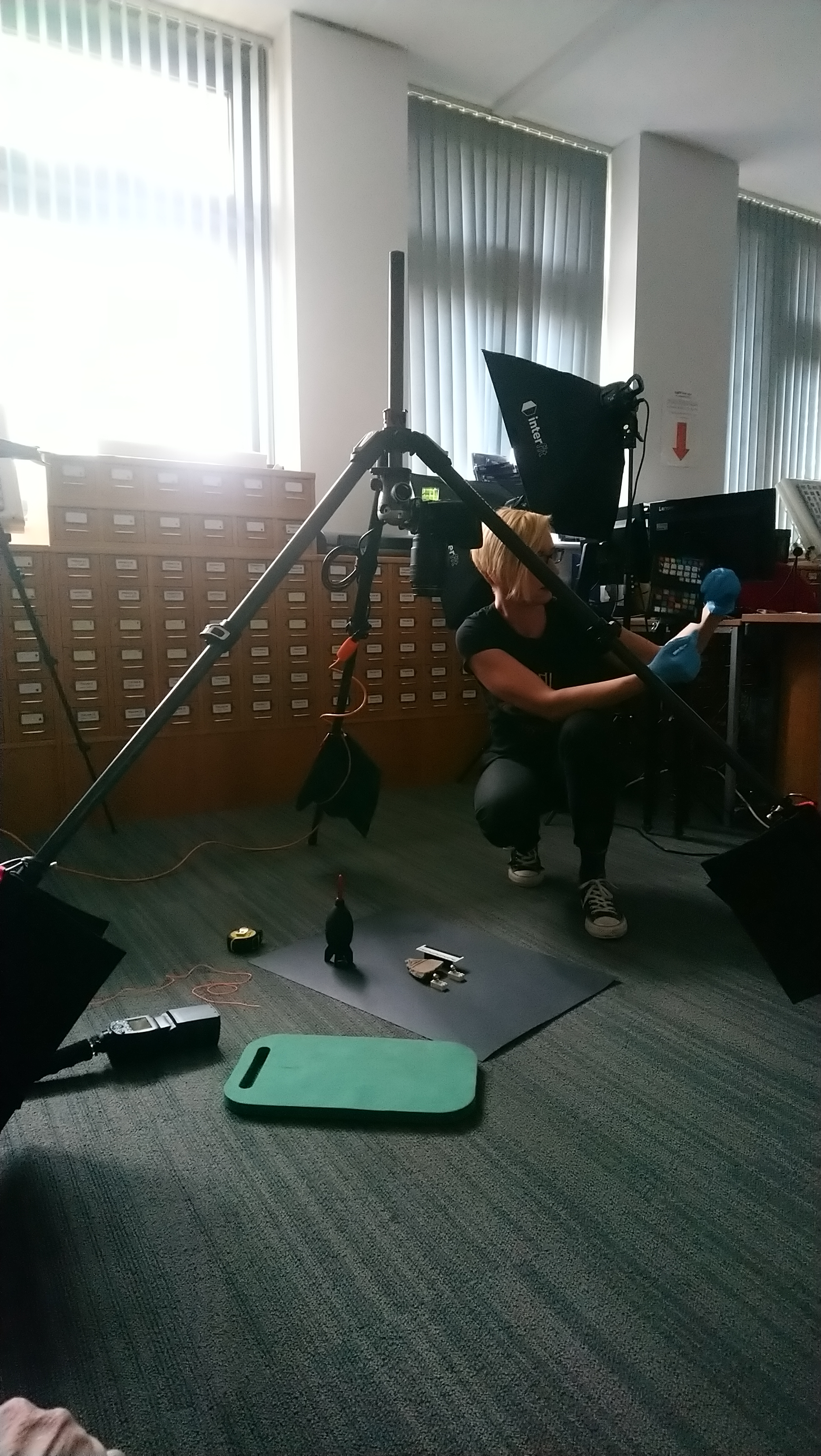A guest blog by Alex Meyer
In this blog Alex Meyer (Western University, Ontario) tells us about his project Illuminating the Vindolanda Tablets which started last year and in which the LatinNow team is involved: Alex Mullen is a Co-Investigator and Anna Willi has been writing messages on replica tablets made by Roy Lawson to put in the CT scanner… For RTI work in 2019 on the Vindolanda tablets led by LatinNow at Blythe House, see our video.

The pandemic hasn’t been great for research that seeks to generate new evidence based on physical artefacts. It has been hard or impossible to travel and many libraries and museums have limited access to or closed their collections. Fortunately, digital technologies are making artefacts more and more accessible to scholars around world. For example, while I haven’t been able to travel outside of North America in the last seventeen months, work on Illuminating the Vindolanda Stylus Tablets has resumed in my absence and is producing new high-resolution 3D images of stylus tablets from Vindolanda. Vindolanda is most famous for its extensive collection of ink tablets, but excavations on the site have also produced over 300 stylus tablets. Although about a quarter of those stylus tablets have visible writing on them, none of them have yet been published, because the writing that remains is illegible using current techniques.

This past month the Illuminating the Vindolanda Writing Tablets project, with the assistance of James Miles from Archaeovision, was able to use a state-of-the-art 3D laser scanner to examine some of the unpublished stylus tablets from Vindolanda Roman Fort now on loan to the Vindolanda Trust from the British Museum. These scans are accurate to approximately 30 microns (.03 mm). We hope that scans of this accuracy along with new image manipulation techniques will allow us to read previously illegible tablets.

Over the last century several large collections of stylus tablets have been published from places like Pompeii, Vindonissa and London, but the vast majority of tablets remain unpublished. Some of these tablets are apparently blank, while others have writing that can’t be made out. This is largely because what writing is preserved on stylus tablets is the result of inadvertent incisions that were made through the wax that once covered the tablets but is now almost always lost. To make matters worse, stylus tablets were generally reused. This means that stylus tablets often have overlapping, fragmentary texts that are difficult to interpret in the best of circumstances.
In order to read the tablets, scholars traditionally depend on their naked eyes, assisted by raking light which serves to highlight the texture of the incisions left behind by over-zealous writers. In the past 25 years, this technique has been augmented by the advent of Reflection Transformation Imaging (RTI), which produces composite digital images of tablets with a virtual, movable light source. This technique has done wonders to help read problematic texts. However, it has its limitations. Color and shading can be misleading and some marks are still too shallow or faint to make out.
Illuminating the Vindolanda Stylus Tablets is a collaboration between me, Alex Mullen of Latin Now, Roger Tomlin of Oxford and Barbara Birley of the Vindolanda Trust, and is funded by the Social Science and Humanities Research Council of Canada. We’re exploring new methods by which we might be able to recover texts preserved on these tablets. High-resolution 3D scanning is just the first step. There are many technologies to apply to this problem. For example, in the coming months we’ll be running a replica tablet through a CT scanner and trying various methods of manipulating the results of the 3D scanning and the CT scan to recover and read texts that have so-far eluded interpretation.
The applications of this research are extensive. Not only may this process represent a significant advance in our knowledge of Vindolanda and the Roman empire’s northern frontier, but these same techniques could be applied to previously illegible stylus tablets from other sites, of which there are hundreds. Similarly, these techniques could be applied to other media, including other types of wooden artefacts, bronze tablets, inscriptions on stone and almost any other inscribed or incised material. Most excitingly, these technologies improve everyday and promise to continue revealing new evidence of the ancient world.
 The LatinNow summer started with a training session for the Faculty of Arts at the University of Nottingham and our team on Digital techniques and resources for textual research. Led by Dr Gabriel Bodard (Institute for Classical Studies, London) and me, the DigiText workshop introduced our colleagues to four major digital approaches to humanities research: digital philology, text encoding, linked open data and linguistic annotation. The topics we covered included introduction to online resources, imaging techniques for cultural heritage, methods in digital palaeography, EpiDoc XML markup, LOD annotation, treebanking and translation alignment. While most of our examples were taken from the ancient Mediterranean, the principles and practices applied to all disciplines and cultures represented in the audience – from Scandinavian studies to modern languages translation studies. Our colleagues enjoyed a good amount of practice, starting with marking up modern gravestones in EpiDoc (the more errors and erasures the better), annotating and disambiguating place names in Recogito and aligning translations in Ugarit. Our aim was to showcase these major topics and what progress has been made in digital classics, as well as to highlight the applicability of these approaches and methodologies to virtually all textual research. We had fruitful discussions and quite a few ideas for future collaboration, both national and international – watch this space!
The LatinNow summer started with a training session for the Faculty of Arts at the University of Nottingham and our team on Digital techniques and resources for textual research. Led by Dr Gabriel Bodard (Institute for Classical Studies, London) and me, the DigiText workshop introduced our colleagues to four major digital approaches to humanities research: digital philology, text encoding, linked open data and linguistic annotation. The topics we covered included introduction to online resources, imaging techniques for cultural heritage, methods in digital palaeography, EpiDoc XML markup, LOD annotation, treebanking and translation alignment. While most of our examples were taken from the ancient Mediterranean, the principles and practices applied to all disciplines and cultures represented in the audience – from Scandinavian studies to modern languages translation studies. Our colleagues enjoyed a good amount of practice, starting with marking up modern gravestones in EpiDoc (the more errors and erasures the better), annotating and disambiguating place names in Recogito and aligning translations in Ugarit. Our aim was to showcase these major topics and what progress has been made in digital classics, as well as to highlight the applicability of these approaches and methodologies to virtually all textual research. We had fruitful discussions and quite a few ideas for future collaboration, both national and international – watch this space!
